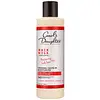What's inside
What's inside
 Key Ingredients
Key Ingredients

 Benefits
Benefits

 Concerns
Concerns

 Ingredients Side-by-side
Ingredients Side-by-side

Water
Skin ConditioningGlycine Soja Oil
EmollientPrunus Amygdalus Dulcis Oil
Skin ConditioningTheobroma Cacao Seed Butter
EmollientButyrospermum Parkii Butter
Skin ConditioningCetearyl Alcohol
EmollientGlycerin
HumectantParfum
MaskingPolysorbate 60
EmulsifyingAgave Tequilana Stem Extract
Ascorbyl Palmitate
AntioxidantAscorbic Acid
AntioxidantBeeswax
Emulsion StabilisingPentaerythrityl Tetra-Di-T-Butyl Hydroxyhydrocinnamate
AntioxidantPolysorbate 80
EmulsifyingPrunus Armeniaca Kernel Oil
MaskingSimmondsia Chinensis Seed Oil
EmollientTocopherol
AntioxidantTriticum Vulgare Germ Oil
EmollientXanthan Gum
EmulsifyingMethylisothiazolinone
PreservativePhenoxyethanol
PreservativeWater, Glycine Soja Oil, Prunus Amygdalus Dulcis Oil, Theobroma Cacao Seed Butter, Butyrospermum Parkii Butter, Cetearyl Alcohol, Glycerin, Parfum, Polysorbate 60, Agave Tequilana Stem Extract, Ascorbyl Palmitate, Ascorbic Acid, Beeswax, Pentaerythrityl Tetra-Di-T-Butyl Hydroxyhydrocinnamate, Polysorbate 80, Prunus Armeniaca Kernel Oil, Simmondsia Chinensis Seed Oil, Tocopherol, Triticum Vulgare Germ Oil, Xanthan Gum, Methylisothiazolinone, Phenoxyethanol
Water
Skin ConditioningShea Butter Ethyl Esters
EmollientCetearyl Alcohol
EmollientBehentrimonium Chloride
PreservativeTocopheryl Acetate
AntioxidantPanthenol
Skin ConditioningMalic Acid
BufferingHydrolyzed Pea Protein
EmollientMalus Domestica Fruit Cell Culture Extract
Skin ConditioningGlycerin
HumectantCitric Acid
BufferingXanthan Gum
EmulsifyingIsopropyl Alcohol
SolventLecithin
EmollientSodium Hydroxide
BufferingPhenoxyethanol
PreservativeDehydroacetic Acid
PreservativeBenzoic Acid
MaskingPotassium Sorbate
PreservativeWater, Shea Butter Ethyl Esters, Cetearyl Alcohol, Behentrimonium Chloride, Tocopheryl Acetate, Panthenol, Malic Acid, Hydrolyzed Pea Protein, Malus Domestica Fruit Cell Culture Extract, Glycerin, Citric Acid, Xanthan Gum, Isopropyl Alcohol, Lecithin, Sodium Hydroxide, Phenoxyethanol, Dehydroacetic Acid, Benzoic Acid, Potassium Sorbate
Ingredients Explained
These ingredients are found in both products.
Ingredients higher up in an ingredient list are typically present in a larger amount.
Cetearyl alcohol is a mixture of two fatty alcohols: cetyl alcohol and stearyl alcohol. It is mainly used as an emulsifier. Emulsifiers help prevent the separation of oils and products. Due to its composition, it can also be used to thicken a product or help create foam.
Cetearyl alcohol is an emollient. Emollients help soothe and hydrate the skin by trapping moisture.
Studies show Cetearyl alcohol is non-toxic and non-irritating. The FDA allows products labeled "alcohol-free" to have fatty alcohols.
This ingredient is usually derived from plant oils such as palm, vegetable, or coconut oils. There is debate on whether this ingredient will cause acne.
Due to the fatty acid base, this ingredient may not be Malassezia folliculitis safe.
Learn more about Cetearyl AlcoholGlycerin is already naturally found in your skin. It helps moisturize and protect your skin.
A study from 2016 found glycerin to be more effective as a humectant than AHAs and hyaluronic acid.
As a humectant, it helps the skin stay hydrated by pulling moisture to your skin. The low molecular weight of glycerin allows it to pull moisture into the deeper layers of your skin.
Hydrated skin improves your skin barrier; Your skin barrier helps protect against irritants and bacteria.
Glycerin has also been found to have antimicrobial and antiviral properties. Due to these properties, glycerin is often used in wound and burn treatments.
In cosmetics, glycerin is usually derived from plants such as soybean or palm. However, it can also be sourced from animals, such as tallow or animal fat.
This ingredient is organic, colorless, odorless, and non-toxic.
Glycerin is the name for this ingredient in American English. British English uses Glycerol/Glycerine.
Learn more about GlycerinPhenoxyethanol is a preservative that has germicide, antimicrobial, and aromatic properties. Studies show that phenoxyethanol can prevent microbial growth. By itself, it has a scent that is similar to that of a rose.
It's often used in formulations along with Caprylyl Glycol to preserve the shelf life of products.
Water. It's the most common cosmetic ingredient of all. You'll usually see it at the top of ingredient lists, meaning that it makes up the largest part of the product.
So why is it so popular? Water most often acts as a solvent - this means that it helps dissolve other ingredients into the formulation.
You'll also recognize water as that liquid we all need to stay alive. If you see this, drink a glass of water. Stay hydrated!
Learn more about WaterXanthan gum is used as a stabilizer and thickener within cosmetic products. It helps give products a sticky, thick feeling - preventing them from being too runny.
On the technical side of things, xanthan gum is a polysaccharide - a combination consisting of multiple sugar molecules bonded together.
Xanthan gum is a pretty common and great ingredient. It is a natural, non-toxic, non-irritating ingredient that is also commonly used in food products.
Learn more about Xanthan Gum